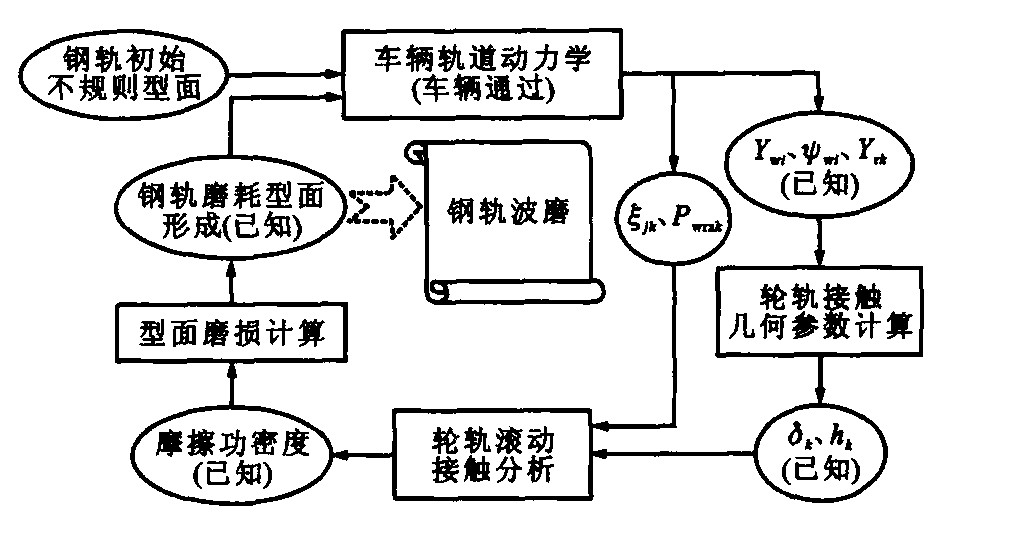Theoretical model and numerical method of rail corrugation
Article Text (Baidu Translation)
-
摘要: 分析了国内外铁路钢轨波浪形磨损理论模型, 提出了车辆轨道垂、横向耦合动力学、轮轨滚动接触力学和钢轨材料摩擦磨损模型为一体的钢轨磨耗型波浪形磨损计算模型, 发展了相应的数值方法。模型中车辆结构和轨道下部结构被简化成等效的质量、弹簧和阻尼系统, 钢轨用Euler梁代替, 并考虑它的垂向、横向弯曲变形和扭转变形, 利用修改的Kalker三维弹性体非Hertz滚动接触理论和相应的数值方法计算轮轨蠕滑力和摩擦功, 假设材料单位面积磨损量正比于轮轨接触面摩擦功密度。利用该模型和相应的数值方法分析了几个磨耗型波磨情况, 结果表明该模型可以模拟轨道多种缺陷(轨缝、扁疤、凹坑、轨枕间距、随机不平顺等因素)引发的钢轨磨耗型初始波磨和发展规律, 可以模拟由于钢轨在机械加工或打磨过程中形成的初始波磨的演化过程, 可以通过改善轨道特性来消除或减少波磨的发生和发展。Abstract: The theoretical models of rail corrugation were analyzed, a theoretical model and its numerical method for rail corrugation attributed to material wear were put forward. In the model, the non-Hertzian rolling contact theory of wheel and rail system, rail material wear model and coupling dynamics of rail vehicle and track in the vertical and lateral directions were combined, a passenger car and the structure under rails were replaced by the systems consisting of dampers, springs and equivalent mass bodies, and the Euler beam was utilized to model the rails accounting for bending and twisting deformations, Kalker's non-Hertzian rolling contact theory of three-dimensional elastic bodies was modified to calculate the creep forces and frictional work density on the contact patch of wheel and rail. It was assumed that the material loss unit area of the contact patch was proportional to the frictional work density that determines the wear depth of the rail running surface. The presented model and its numerical method were used to analyze two kinds of corrugation cases. The results show that the initiation and development of the corrugations caused by various track defects, such as track gap, scratch, dent, sleeper pitch and random geometry irregularities can be analysed, the evolution of initial corrugation on rail running surface caused by manufacturing and grinding can be simulated, they are feasible to protect the initiation and development of rail corrugation.
-
Key words:
- railway engineering /
- rail corrugation /
- evolution /
- rolling contact /
- material wear /
- vehicle and track dynamics
-
表 1 车辆轨道结构等效弹簧和阻尼系数[23]
Table 1. Structure parameters of vehicle and track
刚度Kry/(N·m-1) 刚度Krz/(N·m-1) 刚度Ksy/(N·m-1) 刚度Ksz/(N·m-1) 刚度Kw/(N·m-1) 刚度Kb/(N·m-1) 2.947×107 7.8×107 3.0×107 7.0×107 7.8×107 6.5×107 阻尼Cry/(Ns·m-1) 阻尼Crz/(Ns·m-1) 阻尼Csy/(Ns·m-1) 阻尼Csz/(Ns·m-1) 阻尼Cw/(Ns·m-1) 阻尼Cb/(Ns·m-1) 5.0×104 5.0×104 6.0×104 6.0×104 8.0×104 3.1×104 -
[1] Mair R I. Track design to prevent long-pitch rail corrugation [J]. Bulletin, 1983, 84(4): 289-300. https://www.cnki.com.cn/Article/CJFDTOTAL-GSYT202003017.htm [2] Grassie S L, Gregory R W, Harrison D, et al. The dynamic response of railway track to high frequency vertical/later gitudinal excitation[J]. Journal of Mechanical Engineering Society, 1982, 24(2): 77-102. https://www.cnki.com.cn/Article/CJFDTOTAL-JYGC202105005.htm [3] Ripke B, Knothe K. Die unendlich lange schiene auf diskreten schwellen bei harmonischer einzellasterregung[R]. VDI Fortschritt-Berichte, VDI-Verlag, Düsseldorf, 1991. [4] Frederick C O. A rail corrugation theory[A]. Proceedings of the Second Conference on the Contact Mechanics and Wear of Rail/Wheel Systems[C]. Kingston: University of Vaterloo Press, 1986. [5] Valdivia A. A linear dynamic wear model to explain the initiating mechanism of corrugation[A]. Proceedings of the 10th IAVSD-Symposium[C]. Swets Zeitlinger, Amsterdam/Lisse, 1988. [6] Hempelmann K. Shortpitch corrugation on railway rails: a linear model for prediction[R]. VDI Fortschritt-Berichte, VDI-Verlag, Düsseldorf, 1994. [7] Hempelmann K, Knothe K. An extended linear model for the prediction of short-pitch corrugation[J]. Wear, 1996, 191(2): 161-169. https://www.cnki.com.cn/Article/CJFDTOTAL-JFXG202011015.htm [8] Jin Xue-song, Wang Kai-yun, Wen Ze-feng, et al. Effect of discrete supports of rail on initiation and evolution of rail corrugation[J]. Journal of Mechanical Engineering, 2005, 18(1): 37-41. https://www.cnki.com.cn/Article/CJFDTOTAL-JYGC202101011.htm [9] Jin Xue-song, Wen Ze-feng, Wang Kai-yun, et al. Effect of a scratch on curved rail on initiation and evolution of rail corrugation[J]. Tribology International, 2004, 37(5): 385-394. https://www.cnki.com.cn/Article/CJFDTOTAL-MCXX202002011.htm [10] Jin Xue-song, Wen Ze-feng, Wang Kai-yun. Effect of track irregularities on initiation and evolution of rail corrugation[J]. Journal of Sound and Vibration, 2005, 285(1): 121-135. https://www.cnki.com.cn/Article/CJFDTOTAL-ZGZY202103006.htm [11] JinXuesong, WenZefeng, WangKaiyun, etal. Effectof high frequency vertical vibration of track on formation and evolution of corrugation[J]. Tsinghua Science and Technoloy, 2004, 9(3): 274-280. https://www.cnki.com.cn/Article/CJFDTOTAL-ZGRK202010008.htm [12] Clark R A, Foster P. On the mechanics of rail corrugation formation[A]. Proceeding of the 8th IAVSD-Symposium[C]. Cambridge, MA, Swets Zeitlinger(Amsterdam/Lisse), 1984. [13] Clark R A, Scott G A, Poole W. Short wave corrugationsan explanation based on stick-slip vibrations[J]. Applied Mechanics Rail Transportation Symposium ASME, 1988, 96(2): 141-148. https://www.cnki.com.cn/Article/CJFDTOTAL-LXXB202101001.htm [14] Tassilly E, Vincent N. A linear model for the corrugation of rails[J]. Journal of Sound and Vibration, 1991, 150(1): 25-45. https://www.cnki.com.cn/Article/CJFDTOTAL-GHZJ202101006.htm [15] Tassilly E, Vincent N. Rail corrugations: analytical models and field tests[J]. Wear, 1991, 144(2): 163-178. https://www.cnki.com.cn/Article/CJFDTOTAL-HSYJ201911007.htm [16] Müller S. A linear wheel-rail model to investigate stability and corrugation on straight track[J]. Wear, 2000, 243(2): 122-132. https://www.cnki.com.cn/Article/CJFDTOTAL-CGGL202008001.htm [17] Müller S. A linear wheel-rail model to predict instability and short pitch corrugation[J]. Journal of Sound and Vibration, 1999, 227(5): 899-913. https://www.cnki.com.cn/Article/CJFDTOTAL-YSLX201810014.htm [18] Igeland A. Rail head corrugation growth predictions based non-linear high frequency vehicle/track interaction[J]. Wear, 1997, 213(1): 90-97. https://www.cnki.com.cn/Article/CJFDTOTAL-GGYY201610007.htm [19] Ilias H. The influence of rail-pad stiffness on wheelset/track interaction and corrugation growth[J]. Journal of Sound and Vibration, 1999, 227(7): 935-948. https://www.cnki.com.cn/Article/CJFDTOTAL-NYJS202010007.htm [20] Nielsen J B. A nonlinear wear model[J]. ASME, Rail Transportation, 1997, 13(1): 7-20. https://www.cnki.com.cn/Article/CJFDTOTAL-JYGC202202004.htm [21] Nielsen J B. Evolution of rail corrugation predicted with a nonlinear wear model[J]. Journal of Sound and Vibration, 1999, 227(5): 915-933. https://www.cnki.com.cn/Article/CJFDTOTAL-JGZZ202102032.htm [22] Böhmer A, Klimpel T. Plastic deformation of corrugated rails -a numerical approach using material data of rail steel[J]. Wear, 2002, 253(2): 150-161. https://www.cnki.com.cn/Article/CJFDTOTAL-JSSD202105025.htm [23] 翟婉明. 车辆-轨道耦合动力学[M]. 北京: 中国铁道出版社, 2002. [24] Kalker J J. Three-Dimensional Elastic Bodies in Rolling Contact[M]. Kluwer Academic Publishers, the Netherlands, 1990. [25] Bolton P J, Clayton P, McEwan I J. Rollingsliding wear damage in rail and tyre steels[J]. Wear, 1987, 120(2): 145-165. https://www.cnki.com.cn/Article/CJFDTOTAL-MCXX202201009.htm [26] Clayton P. Tribological aspects of wheel-rail contact: a review of recent experimental research[J]. Wear, 1996, 191(2): 170-183. https://www.cnki.com.cn/Article/CJFDTOTAL-JTTE202106001.htm -





 下载:
下载:










